 Australian Draught competition, Woolbrook, NSW | |
| Country of origin | Australia |
|---|---|
The Australian Draught is a hardy Australian breed of draught horse, noted for its strength and a good temperament.
 Australian Draught competition, Woolbrook, NSW | |
| Country of origin | Australia |
|---|---|
The Australian Draught is a hardy Australian breed of draught horse, noted for its strength and a good temperament.
The Australian Draught was developed over the years as a result of the crossbreeding of the four recognized pure draught horse breeds which were in Australia since the colonial days. These breeds are the Clydesdale, Percheron, Shire, Suffolk Punch, (plus the later imported Belgians) and occasionally some light horse bloodlines, as seen in the part draughts. [1] [2]
The characteristics of these breeds can be found in the Australian Draught, which has produced many colours and types within the breed. All solid colours are accepted, excessive white is not favoured on the face or body, white below the knee is acceptable. [3]


The roots of the Australian Draught Horse date back to the circa 1854 importation of stallions and mares of various English and Flemish cart breeds to Australia. Van Diemen's Land (now Tasmania) was at the forefront of breeding cart and farm horses with the part played by the Van Diemen's Land Company. This company also imported Shire horses, which were later imported to Western Australia and South Australia in the late 1830s.
Bullocks did most of the heavy draught work until the 1850s. The development of the agricultural industry after the gold rushes required a ready supply of draught horses to provide faster load movements. Scottish settlers did much to promote the use of the Clydesdale horses owing to their familiarity with them.
Weinholt Brothers formed a notable draught horse stud at Maryvale, Queensland, in 1885. Most states preferred Shire horses, but in Victoria, the Clydesdale was more popular. Suffolk Punch horses were favoured in northern NSW and on the black-soil country.
The Clydesdale Stud Book was established in Australia in 1915, prior to which breeding was somewhat haphazard. After 1918, tractors were rapidly replacing draught horses until the 1930s depression, when renewed interest in them was kindled. By 1950, tractors had virtually replaced the draught horse on rural properties in Australia. [4]
The Australian Draught Horse Stud Book Society was established around 1979 to promote these horses and breeding programs. Today, the Australian Draught used in led, novelty, ridden, and draught competitions and is still valued as a working horse on small farms throughout Australia. [5] [6]

A draft horse (US), draught horse (UK) or dray horse, less often called a carthorse, work horse or heavy horse, is a large horse bred to be a working animal doing hard tasks such as plowing and other farm labor. There are a number of breeds, with varying characteristics, but all share common traits of strength, patience, and a docile temperament which made them indispensable to generations of pre-industrial farmers.

The Friesian is a horse breed originating in Friesland, in the Netherlands. Although the conformation of the breed resembles that of a light draught horse, Friesians are graceful and nimble for their size. It is believed that during the Middle Ages, ancestors of Friesian horses were in great demand as war horses throughout continental Europe. Through the Early Middle Ages and High Middle Ages, their size enabled them to carry a knight in armour. In the Late Middle Ages, heavier, draught type animals were needed. Though the breed nearly became extinct on more than one occasion, the modern day Friesian horse is growing in numbers and popularity, used both in harness and under saddle. Most recently, the breed is being introduced to the field of dressage, causing the decline of the draught-type with its sturdy legs and back.

The Clydesdale is a Scottish breed of draught horse. It is named for its area of origin, the Clydesdale or valley of the River Clyde, much of which is within the county of Lanarkshire.
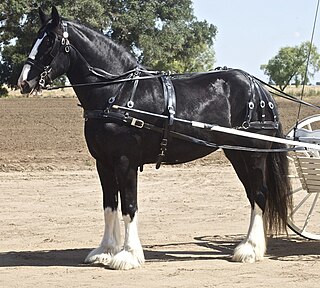
The Shire is a British breed of draught horse. It is usually black, bay, or grey. It is a tall breed, and Shires have at various times held world records both for the largest horse and for the tallest horse. The Shire has a great capacity for weight-pulling; it was used for farm work, to tow barges at a time when the canal system was the principal means of goods transport, and as a cart-horse for road transport. One traditional use was for pulling brewer's drays for delivery of beer, and some are still used in this way; others are used for forestry, for riding and for commercial promotion.
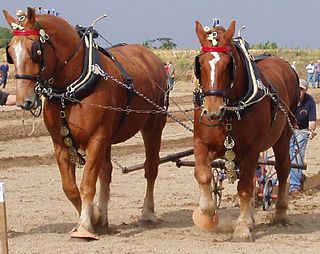
The Suffolk Horse, also historically known as the Suffolk Punch or Suffolk Sorrel, is an English breed of draught horse. The first part of the name is from the county of Suffolk in East Anglia, and the word "Punch" is an old English word for a short stout person. It is a heavy draught horse which is always chestnut in colour, traditionally spelled "chesnut". Suffolk Punches are known as good doers, and tend to have energetic gaits.

The Gypsy Cob, also known as the Traditional Gypsy Cob, Irish Cob, Romani Cob, Gypsy Horse, or Gypsy Vanner, is a type or breed of domestic horse from the islands Great Britain and Ireland. It is a small, solidly-built horse of cob conformation and is often, but not always, piebald or skewbald; it is particularly associated with Irish Travellers and English Romanichal Travellers of Ireland and Great Britain. There was no stud-book or breed registry for horses of this type until 1996, but as breeders developed standards and recorded pedigrees, there are now organizations that register qualifying horses..
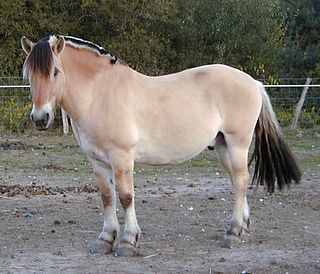
The Fjord or Norwegian Fjord Horse is a relatively small but very strong horse breed from the mountainous regions of western Norway. It is an agile breed of light draught horse build. It is always dun in colour, with five variations in shade recognised in the breed standard. One of the world's oldest breeds, it has been used for hundreds of years as a farm horse in Norway, and in modern times is popular for its generally good temperament. It is used both as a harness horse and under saddle.
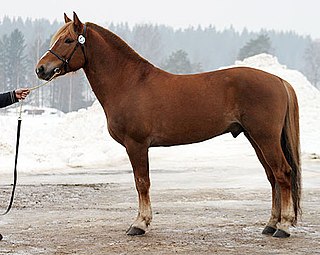
The Finnhorse or Finnish Horse is a horse breed with both riding horse and draught horse influences and characteristics, and is the only breed developed fully in Finland. In English it is sometimes called the Finnish Universal, as the Finns consider the breed capable of fulfilling all of Finland's horse needs, including agricultural and forestry work, harness racing, and riding. In 2007, the breed was declared the official national horse breed of Finland.

The Irish Draught horse is the national horse breed of Ireland which developed primarily for farm use. Today, they are especially popular for crossing with Thoroughbreds and warmbloods, producing the popular Irish Sport Horses which excel at the highest levels of eventing and show jumping.
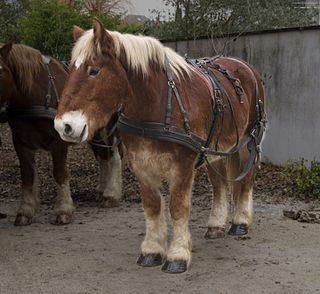
The Trait Breton is a French breed of draught horse. It originated in Brittany, in north-west France, from cross-breeding of local horses with various other breeds. It is strong and muscular, and often has a chestnut coat.
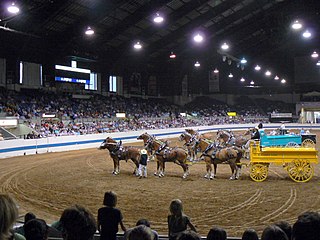
Draft horse showing refers to horse shows exclusively for horses of the draft horse breeds. In North America, though a small number of draft horses are also shown under saddle, the term "Draft horse showing" refers to a specific horse show competition that primarily features driving exhibitors presenting their horses to be judged in harness. Worldwide, some draft horse shows also feature riding classes.

The Belgian Warmblood or Belgisch Warmbloedpaard is a Belgian breed of warmblood sport horse. It is bred for dressage, for show-jumping and for three-day eventing. It is one of three Belgian warmblood breeds or stud-books, the others being the Zangersheide and the Belgian Sport Horse – to which it is quite similar.

The Jutland horse is a draft horse breed originating in Denmark, named after the Jutland Peninsula which forms the western part of the country. Usually chestnut, they are a compact, muscular breed known for their calm and willing temperament. The breed was originally developed for use in agriculture, but today is more often seen in urban settings and at horse shows. Some of the best known members of the breed pull beer wagons for the Carlsberg brewery around Copenhagen, as well as at competitions and for demonstrations. Images from the 9th century show a horse similar to the Jutland being used by Viking raiders in what is now Great Britain. The first written record is from the 12th century, when they were popular as war horses. Some infusion of bloodlines from other breeds occurred in the 18th century, but the modern Jutland type only began about 1850 with the addition of blood from several other breeds, mainly draft horses. A stud book was created in the late 19th century, and the Jutland population grew to a maximum around 15,000 by 1950. Numbers subsequently declined, and as of 2011, only an estimated 1,000 horses remained.

The Soviet Heavy Draft is a Russian breed of heavy draft horse. It derives from the Belgian Brabant heavy draft breed. It was developed in the former Soviet Union for agricultural draft work, and was recognized as a breed in 1952. It is one of several heavy draft breeds developed in the Soviet Union in the twentieth century, others being the Russian Heavy Draft – which derived mainly from the Ardennais – and the Vladimir Heavy Draft, which was derived principally from the Clydesdale.

The Rhenish German Coldblood, German: Rheinisch Deutsches Kaltblut, is a breed of heavy draught horse from the Rhineland area of western Germany. It was bred in second part of the nineteenth century, principally at the Prussian state stud at Schloss Wickrath in Wickrathberg, now part of Mönchengladbach in North Rhine-Westphalia.
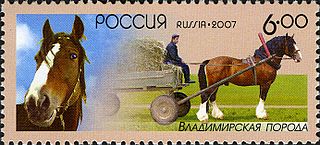
The Vladimir Heavy Draft is a Russian breed of heavy draught horse. It was bred in the early twentieth century in farms and collectives in Ivanovo Oblast and Vladimir Oblast, to the east of Moscow. The most important influence on the development of the breed was from three Clydesdale stallions foaled between 1910 and 1923. The Vladimir was officially recognised in 1946.
The Coffin Bay Pony is a semi-feral horse that developed in Australia. These ponies evolved from foundation bloodstock of 60 Timor Ponies that were imported by English settlers from Indonesia to Coffin Bay, on the southern tip of the Eyre Peninsula at Coffin Bay, South Australia. Coffin Bay Ponies are often confused with Australia's most noted feral horses, the Brumby, which lives in wild mobs all over Australia. However, Coffin Bay ponies live in a fenced protected area.

The known history of the horse in Britain starts with horse remains found in Pakefield, Suffolk, dating from 700,000 BC, and in Boxgrove, West Sussex, dating from 500,000 BC. Early humans were active hunters of horses, and finds from the Ice Age have been recovered from many sites. At that time, land which now forms the British Isles was part of a peninsula attached to continental Europe by a low-lying area now known as "Doggerland", and land animals could migrate freely between what is now island Britain and continental Europe. The domestication of horses, and their use to pull vehicles, had begun in Britain by 2500 BC; by the time of the Roman conquest of Britain, British tribes could assemble armies which included thousands of chariots.

The Schleswig Coldblood is a breed of medium-sized draught horse originally from the historic Schleswig region of the Jutland Peninsula, which today is divided between modern Denmark and Germany, and from which its name derives. It is found primarily in the northern German state of Schleswig-Holstein, and also, in smaller numbers, in Lower Saxony. It shares the origins, ancestry and much of the history of the Danish Jutland breed, and shows some similarity to the British Suffolk Punch. It is used in agriculture and forestry, and to draw coaches and wagons.